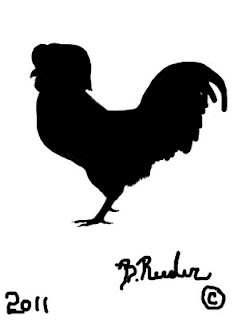 Silhouette
SilhouetteThe silhouette is the outline of the bird. It is a solid black image that focuses attention on the outline of the form.
The definition of ‘silhouette’ from Wikipedia is: “silhouette; the image of a person, an object or scene consisting of the outline and a featureless interior, with the silhouetted object usually being black. Traditionally, a silhouette is a form of artwork, the term originating in the 18th century and applied to portraits or other pictorial representations cut from thin black card.”
In poultry breeding, we use the silhouette to understand how the various traits we are selecting for in our lines create a unique outline, recognizable when completely devoid of detail.
All the classical exhibition breeds are recognizable by silhouette alone if you have much experience with poultry at all. A glance at the silhouette of a Polish makes self-evident what is being indicated, and so too with the Cochin or the Japanese Bantam. Each of the junglefowl shows unique and discernable silhouettes, and while some Asian Game strains are called jungle fowl, their silhouette makes it immediately apparent that they are not really jungle fowl at all, but very modified domestics.
When lines are well selected for the expression of their target form genes, combinations occur that are very recognizable, once you have some familiarity with the breeds either through maintaining them or seeing them regularly at shows.
The common denominator is the silhouette, the outline of the bird, regardless of any factors. Certainly, some recognizable color varieties immediately tell you what you are likely seeing, such as mille fleur, but the D’Uccle is recognizable based on its outline rather than only one of the breeds many color varieties.
There are instances of overlap with some breeds. Some bantam Cornish might be hard to tell apart in silhouette from some Japanese Shamo bantams while some of the simple formed breeds, being jungle fowl like in form, can be harder to tell apart in silhouette unless you are very familiar with them.
Many of the American breeds are very similar in silhouette, but this should come as no surprise as they all have common ancestry through Chinese fowl imported in the mid to late eighteen-hundreds.
These again can be harder for the un-experienced to tell apart. However, a Rock and a Cochin are not mistakable for the other and are immediately distinguishable by their outline, and neither would be mistaken for an Onagadori, whose silhouette is vastly different from the other two. So how can we begin to understand how the Genes of Form and Feathering come together to make the silhouette?

Silhouette as Composite of Form and Feathering Traits
Three groups of heritable factors come together to make the silhouette: skeletal, muscular and feathering. This is not to imply that any of the genes within any given group is related in any way, only to put them into three easily recognizable groups to make our purpose of understanding the silhouette easier. The subject of the genetic factors of these three categories is complex and some of these factors are quantitative in nature.
With the release of my latest book, ‘An Introduction to Form and Feathering of the Domestic Fowl’, I have documented many of these factors. I have classified the heritable factors I discuss by the three categories that make up the silhouette; skeleton, muscles and feathering with the comb-type crowning the silhouette. I will list here from the contents some of the genes I discuss in the book that relate directly to the silhouette.
Genes of Form and Feathering
Skeleton
Wild Type
Extension
Shortening
Horizontal/Vertical
Tail Bud, Tail Angle and Taillessness
Polydactyly
Muscle
Wild Type
Muscle Increase
Muscle Decrease
Feather
Wild Type
Fast and Slow Feathering
Feather Shortening
Feather Lengthening
Feather Count
Feather Thickness
Hen feathering
Leg Feathering
Vulture Hocks
Tight and Loose Feathering
Hookless
Frizzling
Crest and Tuft
Muff and Beard
Ear Tufts
Nakedness
Comb and Wattle
Single Comb
Rose Comb
Pea Comb
Duplex Comb
Buttercup Comb
Composite Combs
Comb and Wattle Size
As you can see, there are many heritable factors involved in the three categories that make the silhouette. The discussion of those genetic factors is too long for this article, but we can briefly consider the three categories and how they come together to make the silhouette.

Building The Silhouette
Skeletal genes can make a shortened form with short extremities (neck, legs, etc) and a forward tilted orientation wherein the center of gravity is to the front of the body, or skeletal genes can make a vertical form with long extremities and the center of gravity directly over the legs.
Feathering is the glory of our fowl. Feathers define birds. There are many feathering genes in our domestic fowl. The most important and fundamental variation is tight, hard feathering and loose, soft feathering. The subject of feathering in the domestic fowl is complex and there are several quantitative factors.
Since it is such a large topic, it is impossible to discuss here, but I cannot stress enough how vital the feathering genes are to the finished silhouette. Just image what a Cochin might look like with no feathers, as compared to what a Cornish would look like with no feathering. Finally, the comb genes make the crown that sits upon the head of the silhouette. While the comb is a small point in the overall silhouette, it is the finishing touch.

Applying the Silhouette to Breeding
Silhouettes are easily made in any paint program. I use a free version of Gimp. Using a picture of your own bird in a side stance, use the paintbrush to white out the background and then blacken in the bird. You may need to increase the screen image size at times and you will need to use variable sizes of the paintbrush, but it is very easy to do. Once you have turned your bird into a silhouette, find or make a silhouette of show winning birds or standard images.

